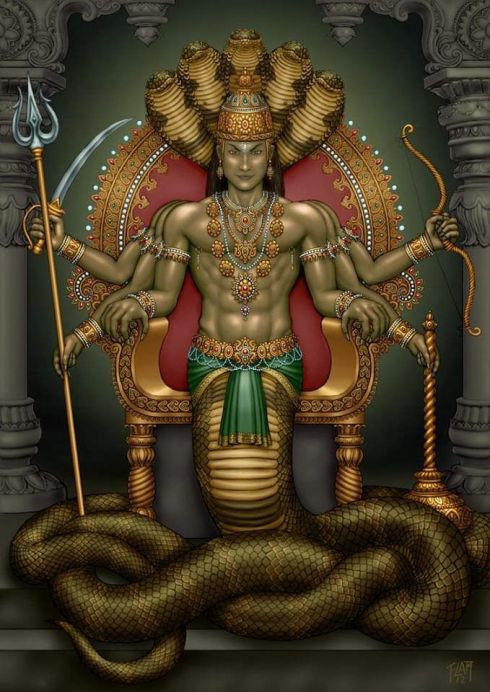
In Hindu mythology there was an entire class of intelligent beings who were snakes—the nāgas (a male is a nāga: a female is a nāgī or nāgiṇī). In contemporary Hinduism the nagas are regarded as the protectors of springs, wells, streams, and rivers. Sometimes nagas assume human form (with all of the abilities, appurtenances, and liabilities) but largely they are huge beautiful king cobras. The nagas tend to live in their own realm, Pātāla, the seventh of the nether kingdoms, yet they appear in other places too and interact with gods, mortals, demons, and animals. Neither evil nor entirely good, the nagas have their own enmities, problems, and tales (although these intersect sometimes with the human protagonists of Hinduism’s great epics and myths).

A particular problem of the nagas is the swift and terrible eagle god Garuda, who is an enemy to the serpent people. He despises them because once he was their slave (through a complex family geas which you will have to look up on your own). Garuda escaped this servitude by bringing the potion of immortality to the nagas, but, as soon as he presented it to them and escaped his servitude, he spilled the potion upon the sword grass. The nagas desperately licked up the remnants from the razor grass…but it is a bit unclear whether they attained immortality or not—the grasss certainly cut their tongues most cruelly and nagas (and snakes) have forked tongues up to this day.

The world itself rests on the head of a naga. The naga prince Shesha practiced such astringent asceticism that Brahma became amazed by him. Shesha’s body (which was already that of a snake) became so knotted and powerful and slender that he slipped downward into a hole which lead all the way to the bottom of the world. There Brahma entrusted him with the sacred burden of holding the entire planet and all of us.

With this in mind, it is unsurprising that in certain parts of India, Bali, and Nepal, the naga are worshiped. Nag stones are a particular object of cultic reverence. Cobras likewise are venerated.

My grandfather grew up in West Virginia (where snakes are taboo in accordance with longstanding Judeo-Christian cultic practice) but his work took him around the world–which was not quite so homogeneous in the 40s, 50s, and 60s! When I was a child he used to tell me stories of the nagas and their struggles. He also told me that one of the defining moments of strangeness in his life was when he was passing through South India and saw a woman put out a saucer for (what grandpa assumed was) a pet. He was surprised when she squeezed some breast milk into it, but stunned when a huge glistening cobra crawled out of a wall and lapped up the milk.


1 comment
Comments feed for this article
October 27, 2017 at 10:17 AM
Beatrix
Hmmm, Garuda is also Lord Vishnu’s ride when he flying about through time & dimension. Cobras often appear as statues in shrines or in paintings depicted deities as ‘protectors’ Why a deity would need protection is beyond me. There’s a big bronze Garuda statue at Kathmandu’s international airport to greet you as you exit your plan.